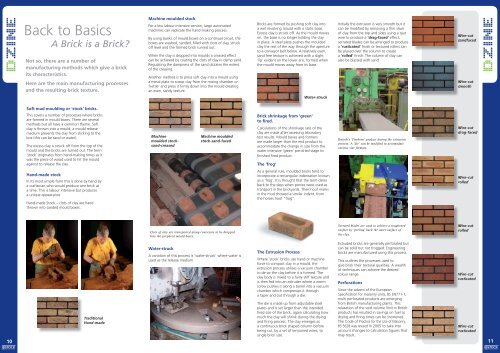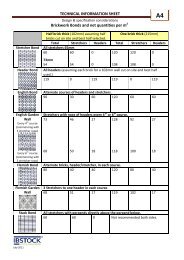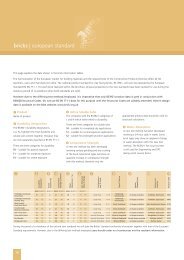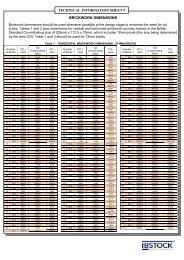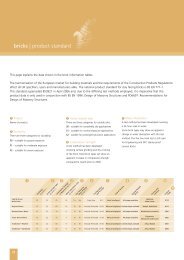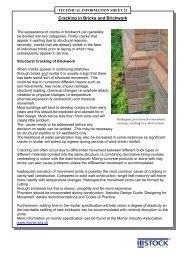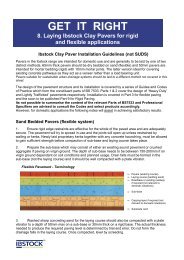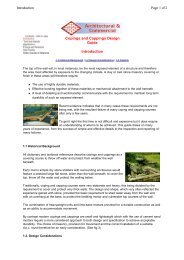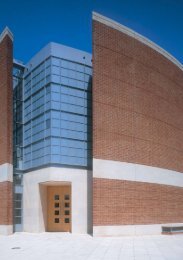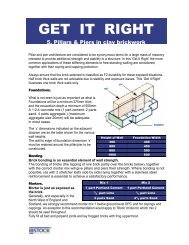Take 3 Architects - Ibstock
Take 3 Architects - Ibstock
Take 3 Architects - Ibstock
You also want an ePaper? Increase the reach of your titles
YUMPU automatically turns print PDFs into web optimized ePapers that Google loves.
10<br />
Back to Basics<br />
Hand-made stock<br />
A Brick is a Brick?<br />
Not so, there are a number of<br />
manufacturing methods which give a brick<br />
its characteristics.<br />
Here are the main manufacturing processes<br />
and the resulting brick texture.<br />
Soft mud moulding or ‘stock’ bricks.<br />
This covers a number of processes where bricks<br />
are formed in mould boxes. There are several<br />
methods but all have a common theme. Soft<br />
clay is thrown into a mould, a mould release<br />
medium prevents the clay from sticking to the<br />
<br />
The excess clay is struck off from the top of the<br />
mould and the bricks are turned out. The term<br />
‘stock’ originates from hand-making times as it<br />
was the piece of wood used to hit the mould<br />
against to release the clay.<br />
In its most simple form this is done by hand by<br />
a craftsman who would produce one brick at<br />
a time. This is labour intensive but produces<br />
a unique appearance.<br />
Hand-made Stock – clots of clay are hand<br />
thrown into sanded mould boxes.<br />
Traditional<br />
Hand-made<br />
Machine moulded stock<br />
For a less labour intensive version, large automated<br />
machines can replicate the hand-making process.<br />
By using banks of mould boxes on a continual circuit, the<br />
boxes are washed, sanded, filled with clots of clay, struck<br />
off level and the formed brick turned out.<br />
When the clay is dropped into moulds a creased effect<br />
can be achieved by coating the clots of clay in damp sand.<br />
Regulating the dampness of the sand dictates the extent<br />
of the creasing.<br />
Another method is to press soft clay into a mould using<br />
a metal plate to scoop clay from the mixing chamber or<br />
‘kettle’ and press it firmly down into the mould creating<br />
an even, sandy texture.<br />
Machine<br />
moulded stocksand-creased<br />
Machine moulded<br />
stock-sand-faced<br />
Clots of clay are transported along conveyors to be dropped<br />
into the prepared mould boxes.<br />
Water-struck<br />
A variation of this process is ‘water-struck’ where water is<br />
used as the release medium.<br />
Bricks are formed by pushing soft clay into<br />
a wet revolving mould with a static base.<br />
Excess clay is struck off. As the mould moves<br />
on, the base is no longer holding the clay<br />
in place. A steel plate pushes the moulded<br />
clay the rest of the way through the aperture<br />
to a conveyor belt below. A relatively even,<br />
sand free texture is achieved with a slight<br />
‘lip’ evident on the lower aris, formed when<br />
the mould moves away from its base.<br />
Brick shrinkage from ‘green’<br />
to fired.<br />
Calculations of the shrinkage rate of the<br />
clay are made after assessing laboratory<br />
test results. Mould boxes and formers<br />
are made larger than the end product to<br />
<br />
water intensive ‘green’ pre-dried stage to<br />
finished fired product.<br />
The ‘frog’<br />
As a general rule, moulded bricks tend to<br />
incorporate a rectangular indentation known<br />
as a ‘frog’. It is thought that the term dates<br />
back to the days when ponies were used as<br />
transport in the brickyards. Their hoof marks<br />
in the mud showed a similar indent, from<br />
the horses hoof “frog”.<br />
The Th Extrusion E t i Process P<br />
Water-struck<br />
Where ‘stock’ bricks use hand or machine<br />
force to compact clay in a mould, the<br />
extrusion process utilises a vacuum chamber<br />
to de-air the clay before it is formed. The<br />
clay body is mixed to a fairly stiff texture and<br />
is then fed into an extruder where a worm<br />
screw pushes it along a barrel into a vacuum<br />
chamber which compresses it through<br />
a taper and out through a die.<br />
The die is made up from adjustable steel<br />
plates and is set larger than the intended<br />
<br />
much the clay will shrink during the drying<br />
and firing process. The clay emerges as<br />
a continuous brick shaped column before<br />
being cut, by a set of tensioned wires, to<br />
<br />
Initially the extrusion is very smooth but it<br />
can be modified by removing a thin sliver<br />
of clay from the top and sides using a taut<br />
wire to produce a ‘drag-faced’ effect,<br />
serrated blades can be arranged to produce<br />
a ‘rusticated’ finish or textured rollers can<br />
be placed over the column to create<br />
a ‘rolled’ finish. The column of clay can<br />
also be blasted with sand.<br />
<strong>Ibstock</strong>’s ‘Fireborn’ product during the extrusion<br />
process. A ‘die’ can be modified to accomodate<br />
various size formats.<br />
Serrated blades are used to achieve a roughened<br />
surface by ‘peeling’ back the outer surface of<br />
the clay.<br />
Extruded bricks are generally perforated but<br />
can be solid but not frogged. Engineering<br />
bricks are manufactured using this process.<br />
This outlines the processes used to<br />
give brick their textural qualities. A wealth<br />
of techniques can achieve the desired<br />
colour range.<br />
Perforations<br />
Since the advent of the European<br />
Specification for masonry units, BS EN771-1,<br />
multi perforated products are emerging<br />
from British manufacturing plants. This<br />
relaxation of the void volume limit in British<br />
products has resulted in savings on fuel as<br />
drying and firing times can be shortened.<br />
The Code of Practice for the Use of Masonry,<br />
BS 5628 was revised in 2005 to take into<br />
account changes to calculation figures that<br />
may result.<br />
Wire-cut W<br />
sandfaced s<br />
Wire-cut W<br />
smooth s<br />
Wire-cut W<br />
drag-faced<br />
d<br />
Wire-cut W<br />
rolled r<br />
Wire-cut W<br />
rolled r<br />
Wire-cut W<br />
rusticated r<br />
Wire-cut W<br />
rusticated r<br />
11


